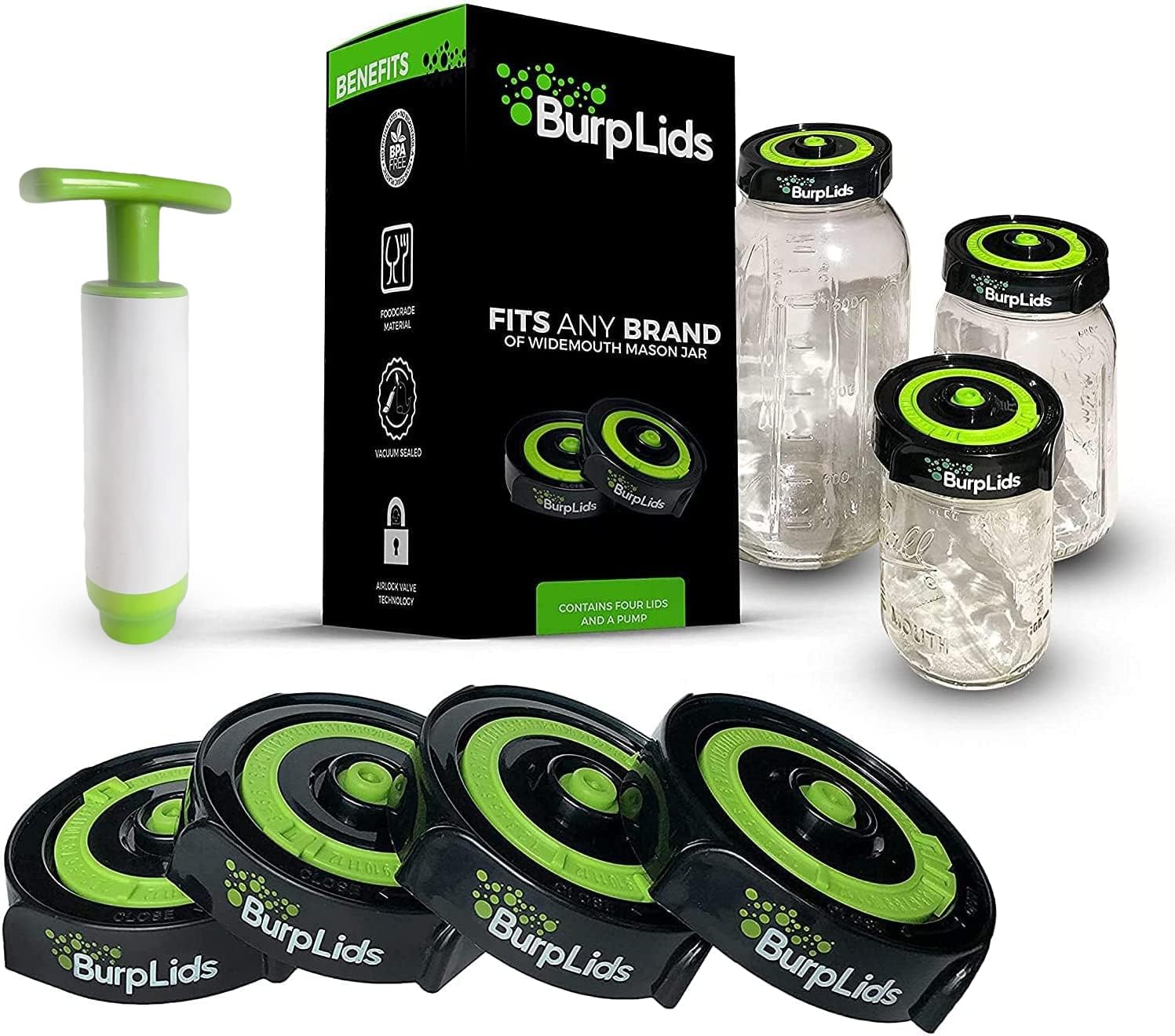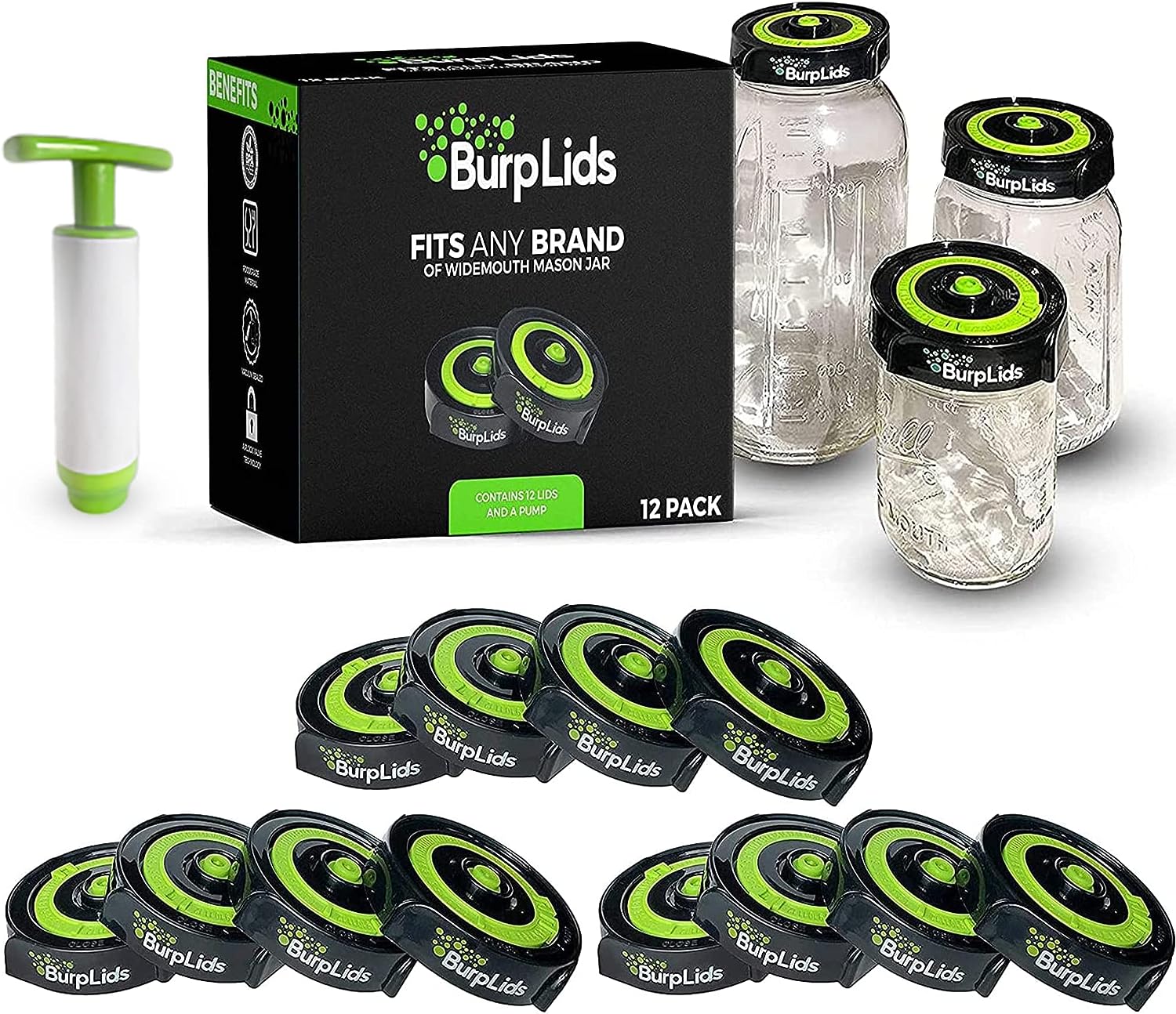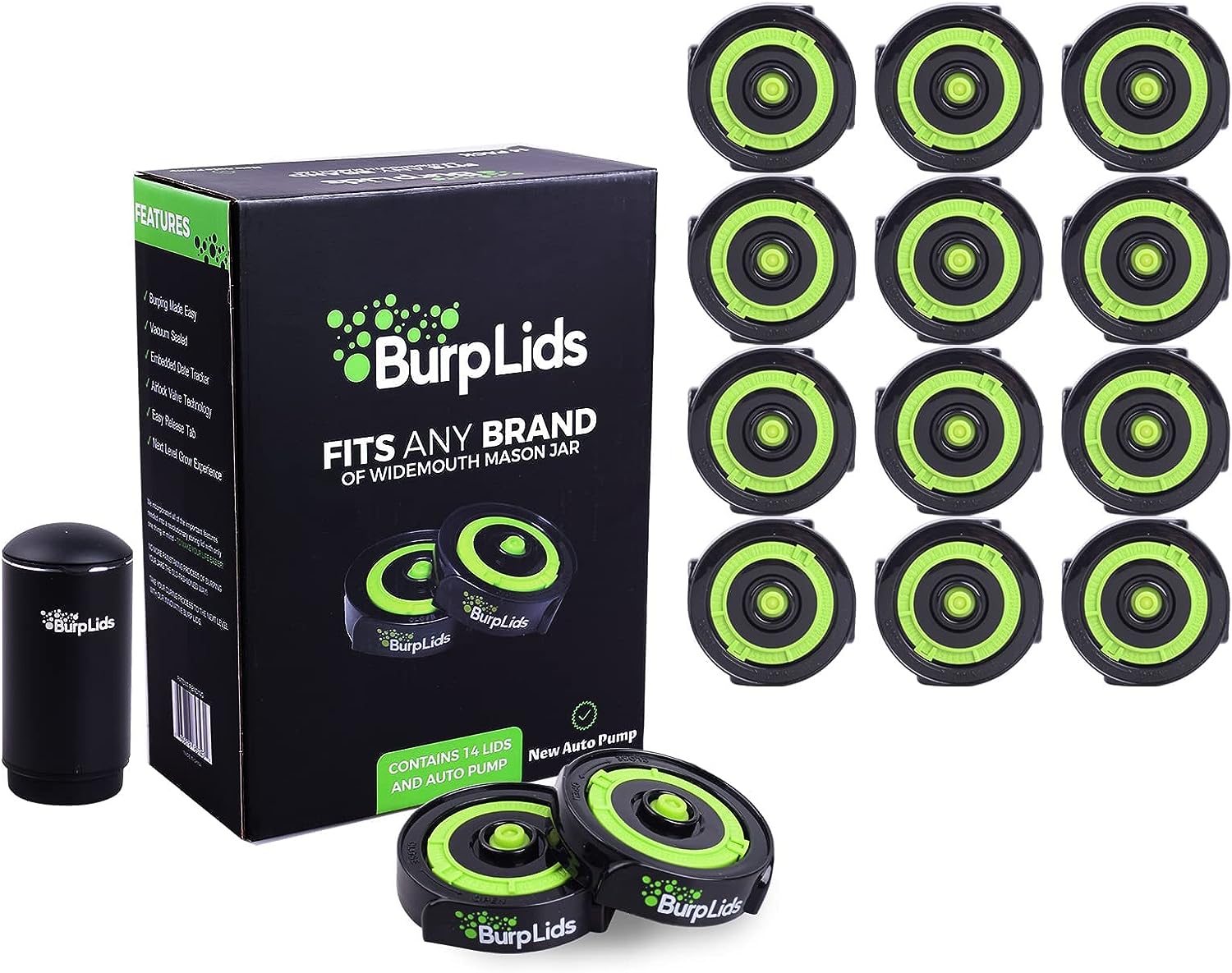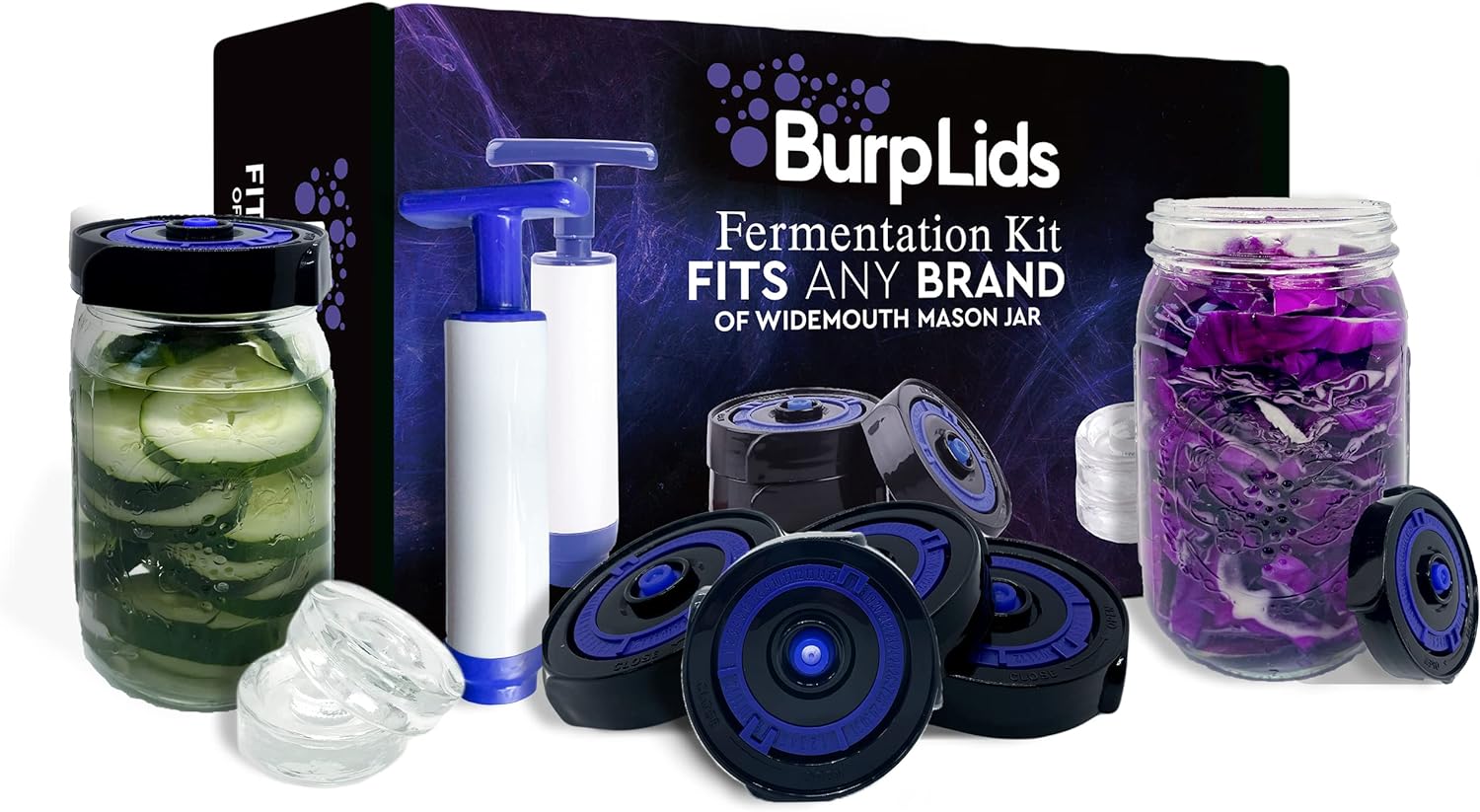Why and How to Ferment
Fermentation is a natural process that transforms food by the action of beneficial bacteria, yeasts, and enzymes. This not only enhances the taste and texture of food, but also offers numerous health benefits. A strong emphasis on gut health and flavorful dishes is what makes fermentation so important in today's culinary world. BurpLids, designed for growers who want to perfect their fermenting skills, provides a convenient and efficient solution to make the fermentation process easier and more successful.
The Benefits of Fermentation: Why to Ferment

Fermentation offers numerous benefits ranging from improving gut health to enhancing the flavor of everyday dishes . In this section, we will explore the key reasons why incorporating fermented foods into your diet is a smart choice.
Understanding the Fermentation Process in Biology goes beyond these immediate benefits, encompassing a broader environmental and evolutionary impact. This process not only contributes to human health but also plays a critical role in the Earth's carbon cycle and the sustainability of food systems. Delving into fermentation's biological importance, we uncover a harmonious relationship between humans and microorganisms that has developed over millennia and continues to thrive in our kitchens today.
Probiotics and Gut Health
One of the most well-known benefits of fermented foods is their rich probiotic content. Probiotics are beneficial bacteria that promote a healthy gut environment, which in turn supports optimal digestion and nutrient absorption. By including fermented foods in your meals, you can give your gut health a significant boost.
Enhancing Flavor in Everyday Dishes
Fermentation can elevate the taste of various dishes by adding a unique tangy and savory flavor profile. This can be especially helpful if you are looking to add more depth and complexity to your meals. Experimenting with different fermented ingredients can help you discover new and exciting flavor combinations.
Brain Health and Reducing Oxidative Stress
Research has shown that there is a strong connection between gut health and brain function. Fermented foods can contribute to overall brain health by reducing oxidative stress and improving the intestinal barrier. This can lead to better cognitive function and a reduced risk of developing neurodegenerative conditions.
Preserving Food and Reducing Waste
Fermentation is an ancient food preservation technique that has been used for centuries. By fermenting your fruits and vegetables, you can extend their shelf life and reduce food waste. This can be particularly helpful for those who have a surplus of garden produce or want to make the most of seasonal ingredients.
In conclusion, there are numerous reasons to consider fermenting foods, from improving your gut health to enhancing the flavors of your favorite dishes. By experimenting with fermentation, you can unlock a world of culinary possibilities and provide your body with essential probiotics for optimal health.
The Fermentation Process: How to Ferment
Fermentation is a simple yet intricate process that can elevate the flavors of your favorite vegetables. This section will guide you through the essential steps to ensure a successful fermentation experience, from selecting the right vegetables to utilizing BurpLids for an efficient process.
Choosing the Right Vegetables for Fermentation
When it comes to fermenting, not all vegetables are created equal. Some vegetables are better suited for the process due to their natural sugars, which promote healthy bacterial growth. Examples of vegetables that are ideal for fermentation include:
- Cabbage
- Cucumbers
- Carrots
- Radishes
- Beets
- Peppers
Feel free to get creative and mix different vegetables to create unique flavor combinations!
Preparing the Vegetables
Before fermenting, it's important to thoroughly wash and chop your chosen vegetables. This ensures that any dirt or contaminants are removed and that the vegetables are in smaller, manageable pieces. Depending on the recipe, you may need to grate, slice, or dice your vegetables.
Adding Brine and Using the Right Salt
Creating a brine is essential for successful fermentation. The brine is a simple mixture of water and salt that helps to preserve the vegetables and promote the growth of beneficial bacteria. It's important to use high-quality, non-iodized salt, such as sea salt or kosher salt. Iodized salt can inhibit fermentation and affect the final taste of your fermented vegetables.
Letting the Vegetables Ferment
Once your vegetables are prepped and submerged in brine, it's time to let the magic happen. The fermentation process can take anywhere from a few days to several weeks, depending on the vegetables, temperature, and desired level of sourness. Make sure to keep your fermenting vegetables in a dark, cool place to encourage proper fermentation.
Utilizing BurpLids for an Efficient Fermentation Process
To make the fermentation process even easier and more efficient, consider using BurpLids. These innovative vacuum-sealed lids fit all wide mouth mason jar containers, allowing for a successful cure. The extraction pump included in the BurpLids kit ensures an easy and efficient fermentation process, eliminating the need for daily burping of mason jar lids. With BurpLids, you can enjoy delicious fermented vegetables without any hassle.
Fermentation Tips and Tricks

When it comes to fermenting food, success lies in the details. In this section, we'll explore some tips and tricks to ensure a smooth fermentation process while avoiding common mistakes.
Using a Proper Container for Fermentation
Selecting the right container is crucial for a successful fermentation. Glass jars, such as wide-mouth mason jars, are a popular choice as they are non-reactive and easy to clean. When using mason jars, vacuum-sealed lids like BurpLids can be particularly helpful in ensuring an efficient fermentation process. Make sure the container is clean and sterilized before use, and avoid using metal or plastic containers that may react with the fermenting food.
Finding the Right Dark Area and Temperature for Fermentation
The fermentation process thrives in a dark environment with a stable temperature. Storing your fermentation container in a cool, dark place like a cabinet or pantry can help to maintain consistent conditions. The ideal temperature for most fermentation processes is between 60-70°F (15-21°C). Be mindful of temperature fluctuations and avoid direct sunlight, as these factors can impact the fermentation process.
Mistakes to Avoid During the Fermentation Process
While fermenting food can be a fun and rewarding experience, it's essential to be aware of potential pitfalls. Some common mistakes to avoid during the fermentation process include:
- Using iodized salt: Iodized salt can inhibit fermentation, so it's best to use non-iodized salt, such as sea salt or pickling salt.
- Not using enough salt: Salt plays a crucial role in the fermentation process by inhibiting harmful bacteria. Make sure to use the recommended amount of salt for the specific recipe you're following.
- Not submerging the vegetables: During fermentation, it's important to keep the vegetables submerged under the brine to prevent the growth of mold or harmful bacteria. You can use fermentation weights or other suitable objects to keep the vegetables submerged.
- Rushing the process: Fermentation takes time and patience. Cutting the process short can result in less flavorful and less beneficial fermented foods. Follow the suggested fermentation time for the recipe you're using and adjust according to taste.
By following these tips and tricks, you'll be well on your way to successful fermentation and reaping the delicious and healthful benefits it has to offer.
Fermentation Experimentation: Recipes and Ideas
Embarking on a fermentation journey doesn't have to be intimidating. In fact, there are several delicious fermented recipes that are easy to make and great for beginners. Below are some classic fermented dishes that showcase the versatility and flavor enhancements that fermentation can bring to your meals.
Sauerkraut: A Classic Fermented Dish
Sauerkraut is a well-known fermented dish made from cabbage and salt. The process involves massaging the cabbage with salt to release its natural juices, then packing it tightly into a fermentation vessel. After a few weeks, the cabbage transforms into a tangy and delicious sauerkraut that can be used as a side dish or added to sandwiches, salads, or even as a pizza topping.
Kimchi: A Spicy Korean Staple
Another popular fermented dish is kimchi, a spicy Korean staple made from napa cabbage, radishes, and a variety of seasonings. The process is similar to sauerkraut but includes additional ingredients such as garlic, ginger, and Korean red pepper flakes. Once fermented, kimchi can be enjoyed on its own, mixed into rice dishes, or even added to a grilled cheese sandwich for a unique and flavorful twist.
Fermented Pickles: A Tangy and Crunchy Treat
Fermented pickles offer a tangy and crunchy treat that is perfect for snacking or adding to your favorite burger. To make fermented pickles, simply soak cucumbers in a saltwater brine with garlic, dill, and other desired spices. The fermentation process can take anywhere from a few days to a couple of weeks, depending on the desired level of tanginess.
Kefir: A Probiotic-Packed Dairy Product
For those looking for a probiotic-packed dairy product, kefir is a great option. Made from milk and kefir grains, this fermented beverage has a slightly tangy taste and a thinner consistency than yogurt. Kefir can be enjoyed on its own, mixed into smoothies, or used as a base for salad dressings and sauces.
By experimenting with these recipes and ideas, you'll be well on your way to enjoying the many benefits of fermented foods. Remember to maintain a casual, friendly, and enthusiastic tone while trying new fermentation recipes, and never be afraid to get creative in the kitchen.
BurpLids: Revolutionizing the Fermentation Process
When it comes to fermenting foods at home, having the right tools can make all the difference. Enter BurpLids, a product designed to revolutionize the fermentation process by making it easier, more efficient, and more successful. Let's explore the features of BurpLids that make it a game-changer in the world of fermentation.
Vacuum-sealed lids for successful curing
One of the key features of BurpLids is the vacuum-sealed lids that play a crucial role in the curing process. By providing an airtight seal, these lids ensure that the necessary anaerobic environment is maintained, which is essential for successful fermentation. This eliminates the need for daily burping of mason jar lids and leads to a more consistent and flavorful end product.
Extraction pumps for easy and efficient fermentation
BurpLids comes with extraction pumps that make the fermentation process even more streamlined and efficient. The pumps help remove excess air from the mason jars, maintaining the right conditions for fermentation. This not only saves time and effort but also reduces the risk of spoilage and contamination, resulting in a better fermentation experience for home growers.
Compatible with wide mouth mason jar containers
Another advantage of using BurpLids is their compatibility with wide mouth mason jar containers. This means that you can easily use them with the jars you already have at home, making it a convenient and cost-effective solution for fermenting your favorite foods. The versatility of BurpLids ensures that you can ferment a wide variety of foods without having to invest in multiple specialized containers.
Different kits and accessories available for various needs
BurpLids offers a range of kits and accessories to cater to different fermentation needs. Whether you're a beginner or an experienced fermenter, there's a BurpLids kit that suits your requirements. From basic kits with just the lids and extraction pumps to more advanced options featuring auto pump technology and additional accessories, there's something for everyone. Plus, the prices of BurpLids products range from $14.99 to $139.99, making it an accessible option for all budgets.
In conclusion, BurpLids has revolutionized the fermentation process by offering an easy, efficient, and successful solution for fermenting your favorite foods at home. So why not give it a try and improve your health and culinary skills? Check out BurpLids products and get a chance to win a premium fermenting lids kit valued at $139!
Embark on a Fermentation Adventure
Now that you've learned about the health and culinary benefits of fermentation, it's time to give it a try and elevate your meals! Remember, BurpLids can be a game-changer in your fermentation journey by providing vacuum-sealed lids and extraction pumps for a successful cure. So why wait? Improve your gut health, tantalize your taste buds, and impress your friends with your newfound fermentation skills.
Ready to ferment like a pro? Check out BurpLids products and enter for a chance to win a premium fermenting lids kit valued at $139 !
 Plastic BurpLids® Curing Kit
Plastic BurpLids® Curing Kit
 BurpLids® 12 Pack Curing Kit
BurpLids® 12 Pack Curing Kit
 BurpLids® 14 Pack Curing Kit
BurpLids® 14 Pack Curing Kit
 BurpLids® Pack Of 4 Fermentation Kit
BurpLids® Pack Of 4 Fermentation Kit





